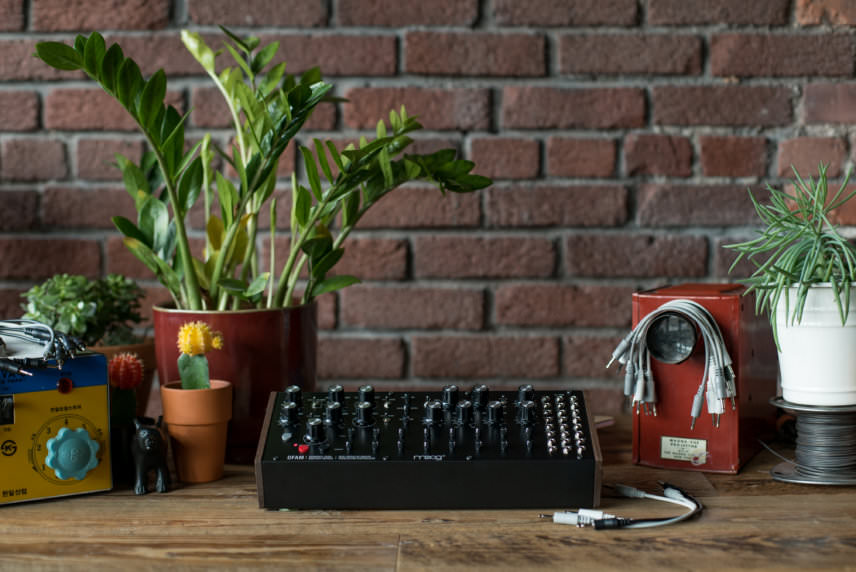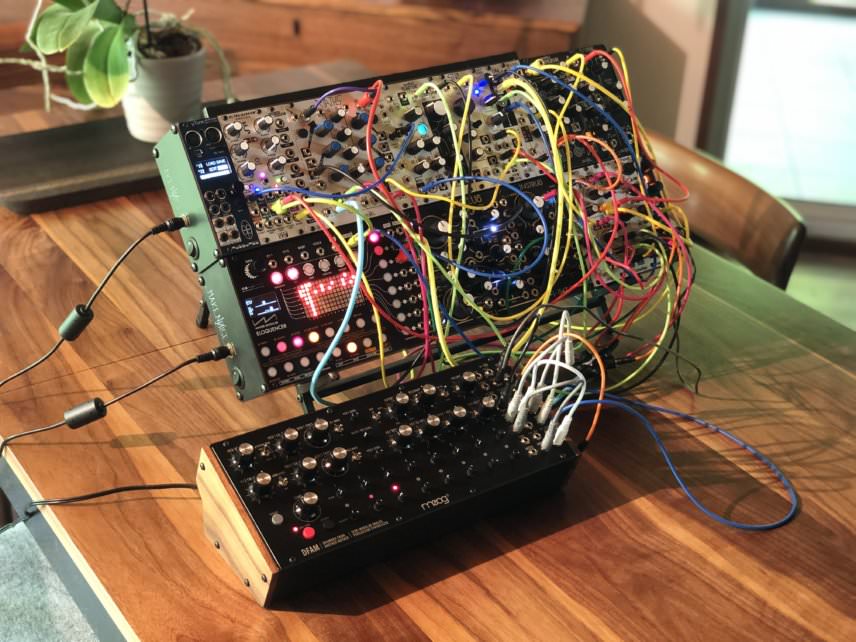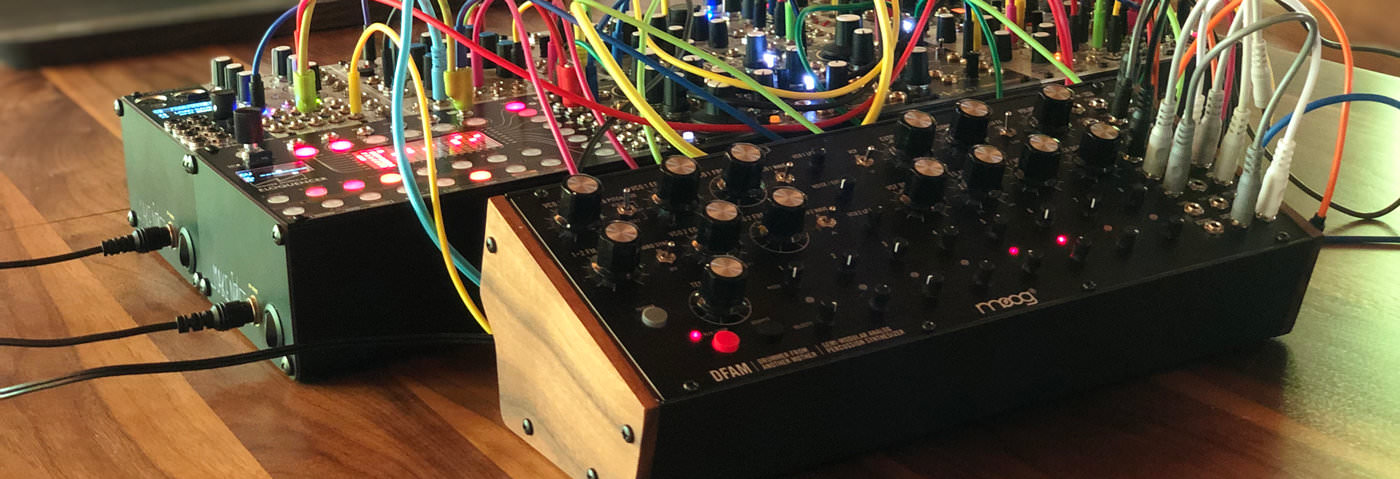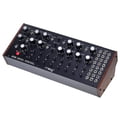Darren Selement reveals how Moog’s Drummer From Another Mother changed his life.
Let me begin with this: I avoided modular for as long as I could. All eurocrack/addiction references aside, I know I dive in and react to new projects rather than pause. That is not a particularly healthy personality device when it comes to modular. I still jumped. It took the DFAM and some sage advice to evolve this default trait of mine into the way I approached Modular Synthesis.
Part 1
Accidents will happen
My wife bought me the DFAM as a gift. (Full disclosure: she knows I have a problem with drum machines.) I didn’t know I wanted it. Little did I know how much I needed it.
For decades I have learned to program by twisting knobs and pushing faders. After a while the manual gets involved and somewhere down the line the turns and thrusts make sense and finally the machine does mostly as it is told. Standard synth stuff, right?

Modular doesn’t agree from the start. It only gets meaner over time. Next thing you know nineteen cables are plugged into varying places, with various multis, the patch sounds great but the smile outside hides the deeper discord; I am a poser. Walk away from the machine, quickly, and avoid the shame. Turn back around and without a doubt, I would convince myself I was fully aware of what each cable was plugged into, why that particular input/output was chosen, and not only what was happening to the sound but that the choice made was exactly what I intended. We’ve all been there, too.
This is where the DFAM changes my modular life.
The simple is easy
The DFAM is semi-modular. Plug it in and sound basically comes out. Moog includes cardboard templates for the faint of heart. The cool part of the simple is that every patch point on the faceplate is clearly labeled. There are no cryptic symbols or semi-esoteric names in color schemes that may or often may not be obvious. The outs are screened in knock-out boxes with names like Velocity. The ins are printed in white with names like VCF DECAY. Shove grey patch cable into an In and the other end into an Out and something happens, or not. You don’t need to be a CV guru to understand the layout.
The hook, or one part of what makes the machine special, is that the DFAM is, in essence, a drum machine. Press play and the sequencer runs in real-time. Meaning any patch bay change is not only immediate, but clearly relatable without an oscilloscope. Patch the PITCH out to the 1➝2 FM AMOUNT and FM synthesis is no longer theory. It is there to witness. Plug the Velocity out into the VCF Decay, twist each of the eight velocity pots through the eight-step sequencer, and voila, the eyes see in the knobs what the ears hear outloud.
This is all Modular 101, I get it. I like the interface, I get it. I know every modular system can do this but again, the DFAM is all about the proximity and immediacy. For someone getting started in modular the risk to reward ratio is amazing. More importantly, the front panel layout of the DFAM inherently communicates so much about the intricate and intertwined life of modular synthesis without leading directly to confusion. The patch bay, the sequencer, and the switches (ahh, the switches) are more than a commonsense map, they are a template to the essence of modular.

All of the above wasn’t what changed my modular existence, though.
The elegant sequencer of the DFAM was. In one fell twist of my brain and knobs, with a little bit of guidance from my modular-dealer, Modular Synthesis got deep.
The DFAM is intuitive. It is virtually impossible to not create a groove or a line that feels organic and full of life on this machine. Patterns swing easily with simple twists and turns of velocity and pitch. It makes sense in the box. The question I had was how do I make my 6U Eurorack groove like the DFAM moves?
I wanted to know how and why some patches grooved and others were stuttering unintended machine guns or worse yet 16th note heartless robots
I could, by willful accident, create patches that felt great but I couldn’t replicate them. I didn’t want to match the sound. I wanted to know how and why some patches grooved and others were stuttering unintended machine guns or worse yet 16th note heartless robots. We’ve all been there, too. I finally put my ego aside and asked my dealer. He said simply, without disdain, give or take a few words: ‘Oh, I get what you want to do. You need a sequencer that provides at least one Gate/Trigger output to trigger the pitch and volume envelope, and two CV outs – one for pitch, and one for dynamic.’
My mind broke. It was a very d’uh and enlightening moment.
Suddenly things I had been creating in my 6U by accident made sense. Suddenly, I had a better understanding of how to control (loose use of the term) my full modular. Suddenly, and finally, the premise opened doors: Three modulations/gates, moving in real-time, easily discernable, and easy to witness and enter the elegance of the DFAM Sequencer experience.
Replicating the concept in the 6U requires effort and a nice sequencer but the DFAM brought to life the advice I was given. Three easy pieces moving together in complicated time. The random aspects of some of my good patches have given way to intention. It is a great feeling. Things have changed permanently because of the DFAM.
Besides, when I get frustrated and want to throw the 6U through the plate glass window I still have that divine little box to sooth me and remind me modular can be, mostly, somewhat controlled by anybody.
Which leads to…
Part Two
Sage Advice (From people who knew better)
The above may read like an endorsement and, in a manner it is, but not for the DFAM, exactly. There are plenty of semi-modular machines out there which can accomplish the same thing. I happen to have a love affair, a problem, with drum machines. So, the DFAM worked for me. It might be another machine for somebody else. The endorsement instead is for the very first piece of sage advice I received when I reached out to modular designers and dealers, they said, “Take a look at semi-modular.”



I ignored them. I understood the premise of modular. How hard can it be? I wish I had listened. The time and money I invested would have been used differently. I would have sold fewer modules instead of “renting them” at a loss and then having to pack them up and ship them off.
That brings me to the second bit of advice I was given and it has nothing to do with the DFAM. Modular Synthesis doesn’t forgive a lack of fundamental knowledge, both in pocket book and frustration. “Wait and Save and Wait a bit longer.” Those weren’t the exact words said to me but sage none-the-less.
Rather than buy the module that accomplishes immediately what you need, envisions long term circumstances of more or more importantly possibly less. A SSF URA and a 2hp S+H are significantly different both in utility and in cost. The URA is a beast. The 2hp does as it is told. Both handle Sample and Hold well. I doubt I need both in a 6U. One is in a box.
Lastly, everyone I reached out to early on said, and I quote, “buy Patch & Tweak.” I understand this magazine sells the book but that has nothing to do with why I mention the big white bible. Beyond being a rather nice-looking coffee table book, it is the perfect starting point and a fantastic reference tool I return to constantly. I open it often, revert to the tutorials, or just read about an artist’s way of thinking. There is something satisfying, like modular, in having a tactile experience, not a video, next to me that puts me in the same headspace as my 6U machine.
Enough sage advice we’ve all heard and ignored. Back to why the DFAM changed my modular way of thinking.
Like the Minimoog brought a portable and compact hardwired synthesizer to the world, the DFAM’s sequencer and front panel brilliance opened up the subtle, complicated world of modular synthesis. It showed me, not by words and tutorials, but by visceral action in real time how modular can and should work.
I would still own a fairly unreasonable 6U Machine. I will still get frustrated and make wonderful unintended mistakes. However, had I started with a semi-modular machine as elegant but simple as the DFAM I would be ahead of myself; not playing catch up to explaining some great accidents that happened along the way.
Darren Selement is a writer, musician, and admitted Luddite. He has a problem with drum machines. He lives in Chapel Hill, North Carolina. Follow him on Twitter or contact him via email.
Pics: Darren Selement & Moog


 Moog DFAM
Moog DFAM